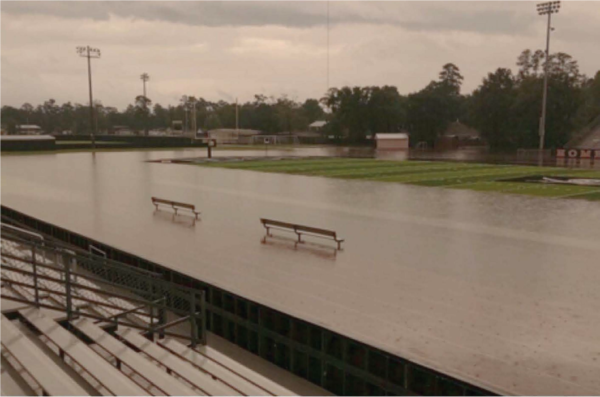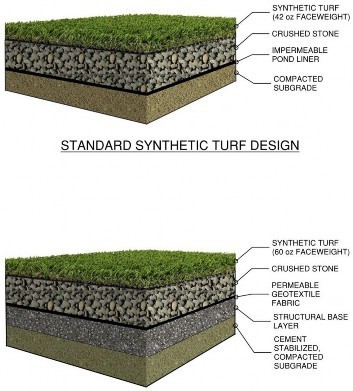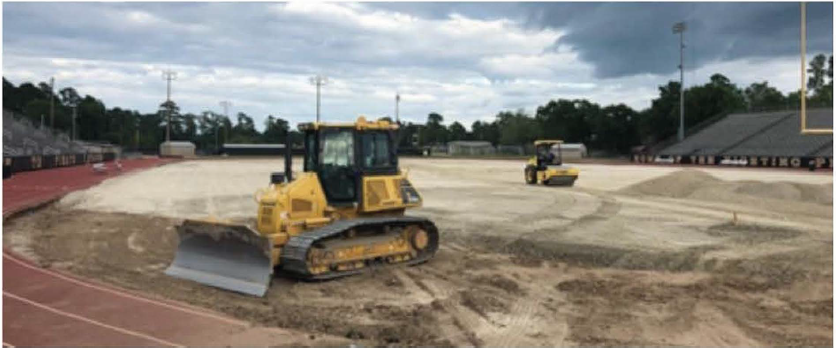
This case study outlines how proper installation and selection of synthetic field turf can mitigate flood damage in flood-prone areas. It's divided in three parts: Reliability, Outcome, and Value.
PART I: ARE SYNTHETIC TURFS RELIABLE IN FLOOD-PRONE AREAS?
Located 90 miles east of Houston, Vidor High School has a football field that is continually subject to an abundance of rainfall and a high groundwater table. It saw the wrath of Hurricane Harvey and Tropical Storm Imelda, both of which left the field beneath floodwaters. Immediately prior to Imelda, Vidor completed the process of installing granular-infill synthetic turf at the field. This case study finds out whether installing synthetic turfs provides reliability to football fields in school districts prone to frequent storms and other natural disasters.

PREVENTING WATER FROM REACHING THE SUBGRADE
With a very soft subgrade and a high groundwater table, the District decided on granular-infill synthetic turf as a means of providing them with a more reliable stadium field. However, the standard design for this type of turf involves drying and compacting the subgrade soils and capping them with an impermeable pond liner to prevent water from reaching the subgrade.
Thus, the integrity of this design relies wholly upon preventing water from reaching the subgrade. In low-lying areas such as Vidor, the possibility of the groundwater table rising from beneath is common, even anticipated when flooding occurs. The standard design was not enough for Vidor.
They needed a subgrade that could:
• Breathe
• Allow groundwater to rise and lower without trapping water beneath a pond liner.
FINDING A SOLUTION
Louisiana is well known for high rainfall and high groundwater tables. McNeese State University, the University of Louisiana at Lafayette, and others where bowl-type stadium designs positioned field surfaces lower than the water table had to address this issue. The projects utilized rock structural base layers with cement stabilized subgrade layers capped with permeable geotextile fabric for these fields.
This type of design provides a subgrade that does not lose strength when saturated and permeable, allowing groundwater to rise and recede naturally without trapping water.

The illustration shows how a subgrade is designed to not lose strength due to saturation.
PART II: THE FOOTBALL FIELD SURVIVES A FLOOD

Stabilized base being placed across the Vidor Field
Groundwater was not the only concern for Vidor's field. Hurricane Harvey proved that the field needed to be able to survive a flood event. A permeable subgrade design would enable the foundation to weather such a storm. To provide a stable surface, the project incorporated granular-infill synthetic turf, BB-sized particles of crumb rubber, and sand that is prone to displacement when submerged.
Where water is an issue, it is essential to specify a turf system that includes a high face-weight value of turf fiber and a combination of monofilament fibers and LSR (slit-film) fibers to provide a field that would encapsulate the granular infill from the onset. Together with the breathable subgrade, Vidor's field can weather any storm, including the next Harvey. Less than two weeks after substantial completion, Tropical Storm Imelda struck.
Although this storm was not as vast reaching as Harvey for Vidor and other Gulf area schools, the impact was the same or even worse. Much of Vidor, including the stadium, was again underwater. The school and the community were once again rising to recover. Just one day after the flood waters receded, the football team resumed use of the field with no substantial issues or damage. School officials were able to place their focus where it belonged - on their campuses and community.
PART III: EVALUATING THE VALUE OF TURF FIELDS
"I absolutely believe what is underneath the turf, and the base foundation is the most important part of the construction of the athletic field and the synthetic turf. Although the field has only been in use for a little over a month, we have seen many rainfall events, including floods, and the field has remained in excellent shape because of the subgrade and drainage system," said David Croak. Assistant Superintendent of Business & Operations at Vidor ISD.
At Vidor, average gate fees for a home game are approximately $15,000, not including concessions. Every canceled event creates a loss of budgeted revenue for the school that has estimated an annual budget of $100,000 from gate fees. "Damage done to a natural grass field can also significantly impact the expenditure side of the budget," said Croak. Over time, the costs of constructing and maintaining a grass field are similar to that of a synthetic turf field. However, turf fields offer a much greater return on investment in many ways, including their reliability.
Had the field been grass here, the Pirates wouldn't have been able to use it, as it would have been too wet. The school would have had to incur losses relocating their events or risk significant damage to the field if used, causing substantial losses in the short and long term.
REAL-WORLD APPLICATIONS BENEFIT STUDENTS
People are crazy about sports and facilities where games are held, but they know little about the role of science and engineering that creates these safe, reliable, and functional facilities. One seldom sees the soil and utilities beneath the field and often enjoys the beautiful facilities on the surface.
"It takes a lot of planning and design to make everything work successfully on a sports field. Any exercise that uses real-world events to create a lesson where a teacher can provide students with the real-world application of the curriculum is meaningful. I can see engineering lessons, finance lessons, and informative writing exercises that students can learn from this project," said Croak.
KEY TAKEAWAYS
- You can create a subgrade that does not lose strength due to saturation.
- Synthetic turf fields consistently provide less disruption to your sporting events.
- Real-world applications of synthetic turf installations can benefit students by increasing available practice time and protecting the consistency of practice conditions.
CEI Engineering is a TASBO Business Sponsor and will be exhibiting at the 2021 TASBO School Operations Conference, Nov 4-5 in Houston, TX.

